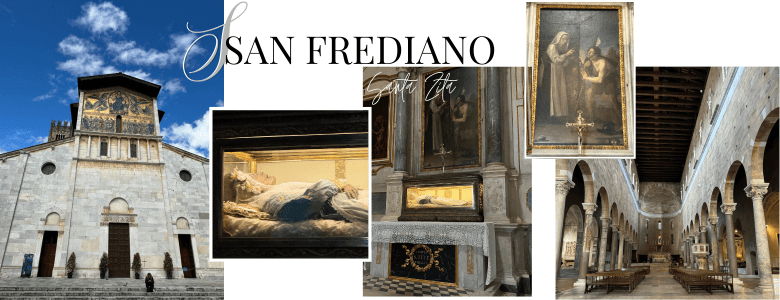Santa Zita, who was born in the town of Monsagrati in 1218, died in Lucca in 1278. She is a religious figure dearest to the people of Lucca. But why? Let me share her special story.
This post contains affiliate links that help keep this website running. By purchasing through our links, we make a small commission at no extra charge to you. Thank you for your support!
During the week of April 27th, Lucca is bursting with color in a floral event to honor Santa Zita. Festivities are held in front of San Frediano and inside Piazza Anfietatro. The event is incredible and I look forward to attending each year. I wait for this time of year to purchase my flowers and herbs for our terrazzo in her honor.

Santa Zita in the Basilica of San Frediano
When you enter the church, on the right side of the chapel are the remains of Santa Zita. I had read that there was an “American Chapel” located next to her. But on a recent visit, I asked the woman at the ticket desk, and she knew nothing about it. Also, nothing is mentioned in the pamphlet they have available about the church.
I had read that this American Chapel was consecrated on July 4, 1776, and most noteworthy, the chapel became the site of local “American” religious celebrations beginning in the 1800s.

When I read about this “chapel” it became special to me, especially being a former New Yorker, to find out that on September 11, 2001, as news of the US tragedy reached Lucca, townspeople gathered at this chapel in solidarity. But now I’m not so sure.
Every year in San Frediano during the celebration of Santa Zita, the urn containing the body of the Saint, is brought to the center of the nave.

Santa Zita is one of the “Incorruptibles” (bodies of Catholic saints) that miraculously did not deteriorate.
The Life of Santa Zita
She began her life as a peasant girl who went to work as a servant in Lucca for a rich weaver named Fontinelli at the age of 12. She was known for her pleasant demeanor, work ethic, and giving leftover bread to the less fortunate.
After many years, she was promoted to head housekeeper. It was then a series of miracles began to reward her hard work. She was so good at her job – it’s said that other servants were jealous of her. It’s said that one day, as she was smuggling bread from the home of the family she worked for, another servant ratted her out to the head of the household.
When Fontinelli pulled open her apron, instead of bread, only flowers fell to the ground. According to legend, when she died at age 60, the church bells spontaneously began to toll.
Santa Zita is the Patron Saint of Lucca and when anyone loses their keys – they pray to her for their recovery.
Interesting Facts About Santa Zita
- In 1580, her body was exhumed and put on display in a traditional silver casket in the church where she had prayed while living in Lucca. She was canonized in 1696.
- I found it interesting that following her death, and associated with the town of Lucca, she was mentioned by Dante in his Divine Comedy: Inferno, 21, v 38. I think it’s funny that when reading about this, he used Santa Zita as a passing reference, expecting his audience to know who he was talking about.
- In 1988, her body was examined by Gino Fornaciari of the University of Pisa. Fornaciari’s studies concluded that Zita had died of lung issues most likely attributed to her inhaling coal dust and smoke.
April 27th in Lucca
Every year on April 27, citizens of Lucca bake bread and bring flowers to San Frediano in celebration of her day. This year I baked a sourdough loaf, my new obsession, and in the Anfietatro, I purchased some tomato plants, herbs, and flowers.










